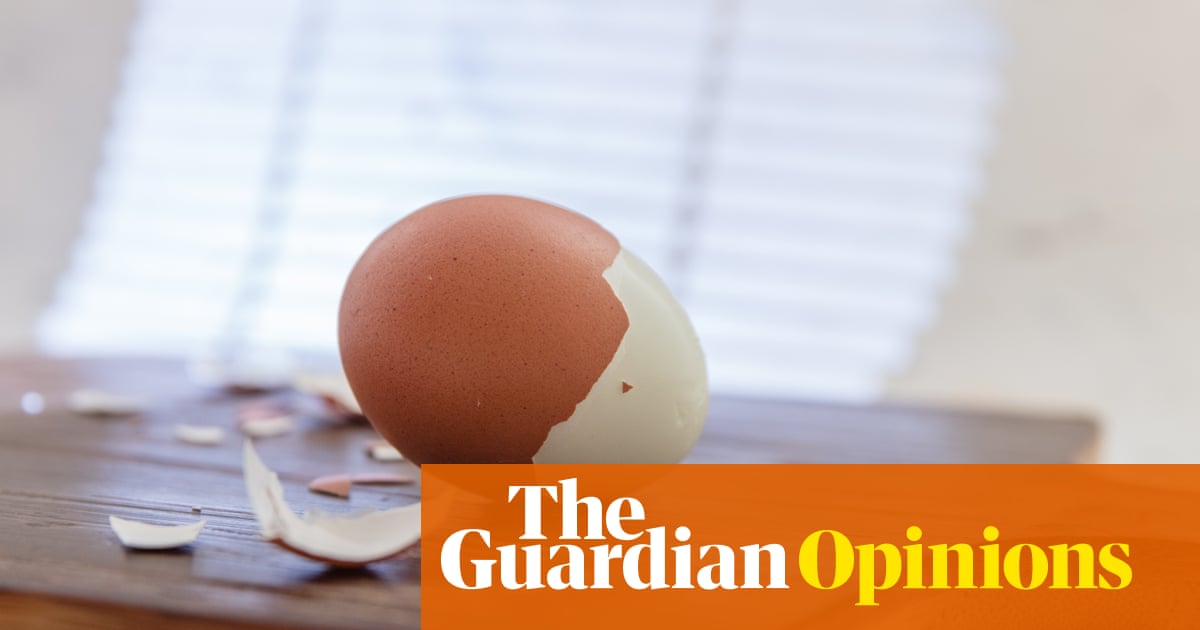
Try our newest merchandise
We’ve all been there – attempting to peel a boiled egg, however mangling it past all recognition because the arduous shell stubbornly sticks to the egg white. Worse, the egg finally ends up lined in chewy bits of adhesive membrane in the long run.
The web is affected by varied “hacks” that declare to stop this drawback. However there are a number of the reason why eggs may be arduous to peel. Fortunately, meaning there are additionally science-based methods we are able to use to keep away from the issue.
Egg ‘peelability’ components
Eggs encompass a tough, porous shell, an internal and outer membrane, the egg white (albumen), and a membrane-encased yolk on the centre. There may be additionally an air cell between the internal and outer membrane subsequent to the shell.
Lots of analysis was carried out within the late Sixties and Nineteen Seventies on components that have an effect on the peelability of eggs after they’ve been boiled.
Considered one of these components is the pH of the egg white. An early research from the Sixties indicated that the pH of the egg white must be within the vary of 8.7–8.9, fairly alkaline, to ensure that the egg to be simpler to peel.
Storage temperature has a job to play, too. A research from 1963 confirmed that storing eggs at about 22C provides a greater peelability outcome than storage at decrease temperatures of 13C, and even fridge temperatures at 3–5C.
After all, there’s a threat of spoilage if eggs are saved at increased ambient temperatures.
Within the research, a rise in storage time earlier than boiling – utilizing much less contemporary eggs – additionally elevated the convenience of peelability.
The 1st step: keep away from contemporary eggs
The truth that contemporary eggs are tougher to peel is comparatively well-known. Based mostly on the components above, there are a few causes for this.
For one, in a contemporary egg the air cell continues to be fairly small. Because the egg ages, it (very) slowly loses moisture by the porous shell, growing the dimensions of the air cell whereas the remainder of the egg contents shrink. An even bigger air cell makes it simpler to start out the peeling motion.
Moreover, egg whites, though they already begin out comparatively alkaline, improve in pH because the eggs age, additionally making them simpler to peel.
Step two: water temperature
Some eager egg boiling pundits imagine that beginning off with boiling water and reducing it to a simmer earlier than gently putting the eggs into it offers a greater outcome. Nonetheless, you wish to do that with room temperature eggs to keep away from them cracking resulting from a sudden temperature change.
The reasoning behind this strategy is that publicity to increased temperatures from the beginning of cooking additionally makes it simpler for the membrane to return away from the shell and egg white.
Moreover, the short scorching begin makes it simpler for the egg white proteins to denature (change construction as they cook dinner) and bond to one another, fairly than to the membrane.
After boiling eggs for the specified period of time (usually three to 5 minutes for runny yolks, six to seven minutes for jammy yolks, and 12 to fifteen minutes for hard-boiled), you’ll be able to quench them in ice water. This could assist the egg white to barely shrink away from the shell, bettering peelability.
Step three (non-compulsory): including issues to the water
Another solutions to enhance peelability embrace including salt to the boiling water, however this has blended outcomes. In a single research, this strategy did truly enhance peelability, however this impact was misplaced after eggs had been saved for longer durations.
Acids and alkali have additionally been proven to help eggshell peelability or elimination. The patent that describes this used fairly harsh substances with the aim to dissolve away the shell.
However primarily based on this concept, you can strive including baking soda or vinegar to the water. With vinegar, the speculation is that it assaults the calcium carbonate within the eggshell to then support its elimination. As for baking soda, as a result of it’s alkaline, it may assist detach the membrane from the shell.
Bonus: various cooking strategies
There are different strategies for hard-cooking eggs, corresponding to stress steaming, air-frying and even microwaving.
In steaming eggs, some proponents theorise that water vapour permeates the eggshell, loosening the membrane from the egg white, and thereby making the egg a lot simpler to peel.
Whereas research have just lately been carried out on the air-frying of different meals, there’s nonetheless scope to additional perceive how this model of cooking may have an effect on eggshells and peelability.
Lastly, upon getting efficiently separated the eggshells, don’t simply throw them within the bin. There are many totally different makes use of for them, together with compost, slug and snail deterrent in your backyard, utilizing them as little biodegradable pots for seedlings, and even one thing as superior as scaffolds for most cancers analysis.





![[2024] MSI Aegis R2 C14NUF9-829US (Intel Core i9-14900F, 128GB DDR5 RAM, 2X 2TB NVMe SSD, NVIDIA GeForce RTX 4070 Ti Super, Windows 11) Gaming Desktop PC](https://m.media-amazon.com/images/I/81i1KVslX4L._AC_SL1500_.jpg)







